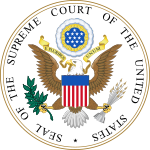
Supreme Court of the United States
Highest court of jurisdiction in the US / From Wikipedia, the free encyclopedia
Dear Wikiwand AI, let's keep it short by simply answering these key questions:
Can you list the top facts and stats about U.S. Supreme Court?
Summarize this article for a 10 year old
The Supreme Court of the United States (SCOTUS) is the highest court in the federal judiciary of the United States. It has ultimate appellate jurisdiction over all U.S. federal court cases, and over state court cases that turn on questions of U.S. constitutional or federal law. It also has original jurisdiction over a narrow range of cases, specifically "all Cases affecting Ambassadors, other public Ministers and Consuls, and those in which a State shall be Party."[2] The court holds the power of judicial review: the ability to invalidate a statute for violating a provision of the Constitution. It is also able to strike down presidential directives for violating either the Constitution or statutory law.[3]
| Supreme Court of the United States | |
|---|---|
 | |
 | |
| 38°53′26″N 77°00′16″W | |
| Established | March 4, 1789; 235 years ago (1789-03-04)[1] |
| Location | 1 First Street, NE, Washington, D.C., U.S. |
| Coordinates | 38°53′26″N 77°00′16″W |
| Composition method | Presidential nomination with Senate confirmation |
| Authorized by | U.S. Constitution |
| Judge term length | Life tenure |
| Number of positions | 9, by statute |
| Website | supremecourt |
| Chief Justice of the United States | |
| Currently | John Roberts |
| Since | September 29, 2005 |
Established by Article Three of the United States Constitution, the composition and procedures of the Supreme Court were originally established by the 1st Congress through the Judiciary Act of 1789. The court consists of nine justices: the chief justice of the United States and eight associate justices, and the justices meet at the Supreme Court Building in Washington, D.C. Justices have lifetime tenure, meaning they remain on the court until they die, retire, resign, or are impeached and removed from office.[3] When a vacancy occurs, the president, with the advice and consent of the Senate, appoints a new justice. Each justice has a single vote in deciding the cases argued before the court. When in the majority, the chief justice decides who writes the opinion of the court; otherwise, the most senior justice in the majority assigns the task of writing the opinion.
The Supreme Court receives on average about 7,000 petitions for writs of certiorari each year, but grants only about 80.[4][better source needed][needs update]